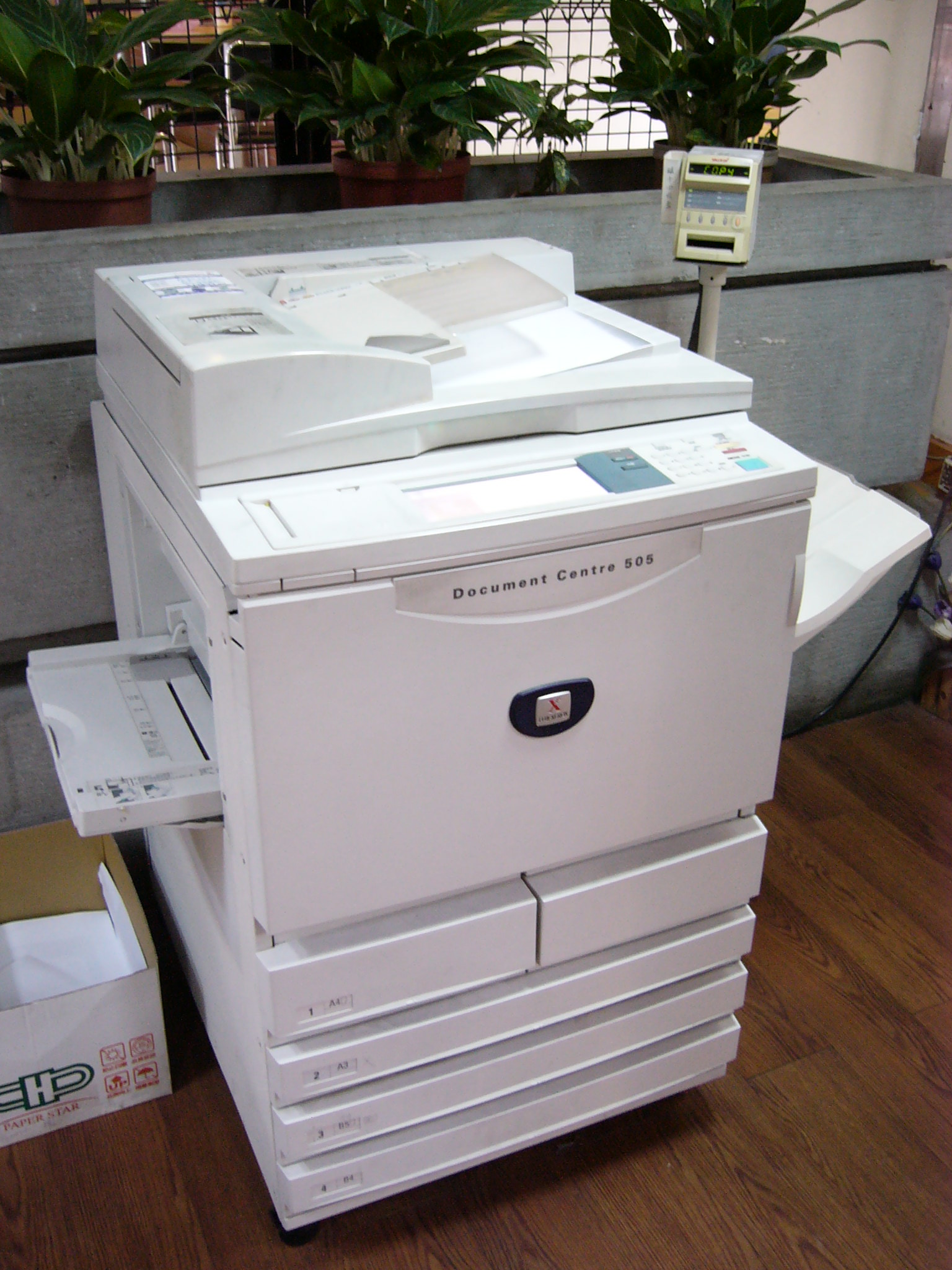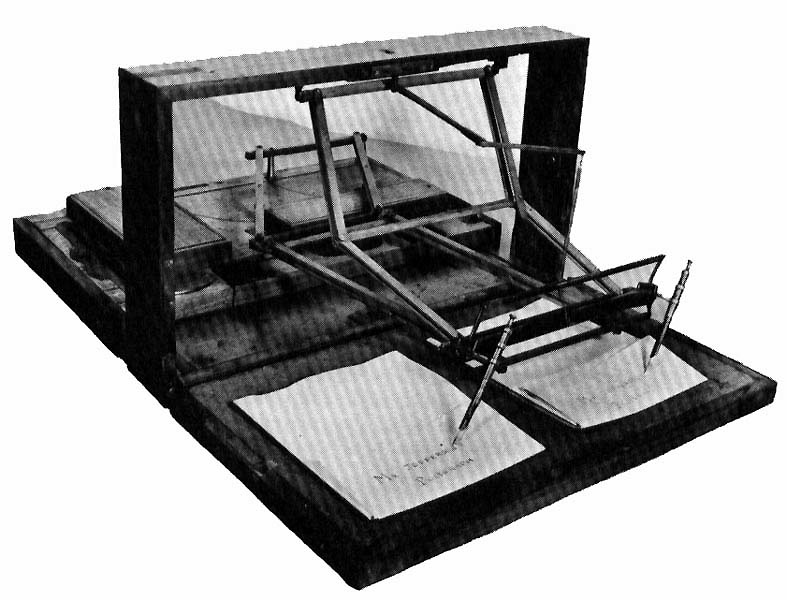|
Reprography
Reprography (a portmanteau of ''reproduction'' and ''photography'') is the reproduction of graphics through mechanical or electrical means, such as photography or xerography. Reprography is commonly used in catalogs and archives, as well as in the architectural reprography, architectural, engineering, and construction industries. Overview In the United States, the industry is relatively small, with approximately 3000 firms. It comprises entrepreneurial businesses serving predominantly the large- and wide-format reproduction needs of the legal, architectural, engineering, manufacturing, retail, and advertising industries. Average sales volume is about $1.5 million per year and average employee counts are 20–25 people. Large-format reproductions are produced with a variety of technologies dependent, in part, on the application of the final product and quantity needed. Examples of typical reproduction methods include: Whiteprint#The diazo printing process, diazo (blueline), elect ... [...More Info...] [...Related Items...] OR: [Wikipedia] [Google] [Baidu] |
Architectural Reprography
Architectural reprography, the reprography of architectural drawings, covers a variety of technologies, media, and supports typically used to make multiple copies of original technical drawings and related records created by architects, landscape architects, engineers, surveyors, mapmakers and other professionals in building and engineering trades. Within the context of archival preservation, the custodians of architectural records must consider many aspects of identification and care when managing the artifactual nature of these materials. Storage containers, handling, paper and chemical compositions and interactions, ultraviolet light exposure, humidity, mold, and other agents of potential harm all interact to determine the longevity of these documents. As well, architectural reprographic drawings are often in very large formats, making storage and handling decisions especially complex. History With the rise of the professionalized practice of western architecture in the secon ... [...More Info...] [...Related Items...] OR: [Wikipedia] [Google] [Baidu] |
Blueprints
A blueprint is a reproduction of a technical drawing or engineering drawing using a contact print process on light-sensitive sheets introduced by Sir John Herschel in 1842. The process allowed rapid and accurate production of an unlimited number of copies. It was widely used for over a century for the reproduction of specification drawings used in construction and industry. Blueprints were characterized by white lines on a blue background, a negative of the original. Color or shades of grey could not be reproduced. The process is obsolete, initially superseded by the diazo-based ''whiteprint'' process, and later by large-format xerographic photocopiers. It has since almost entirely been superseded by digital computer-aided construction drawings. The term ''blueprint'' continues to be used informally to refer to any floor plan (and by analogy, any type of plan). Practising engineers, architects, and drafters often call them "drawings", "prints", or "plans". The blueprint proce ... [...More Info...] [...Related Items...] OR: [Wikipedia] [Google] [Baidu] |
Portmanteau
In linguistics, a blend—also known as a blend word, lexical blend, or portmanteau—is a word formed by combining the meanings, and parts of the sounds, of two or more words together.Garner's Modern American Usage p. 644. English examples include '' smog'', coined by blending ''smoke'' and ''fog'', and '''', from ''motor'' ('' motorist'') and ''hotel''. A blend is similar to a [...More Info...] [...Related Items...] OR: [Wikipedia] [Google] [Baidu] |
Photocopying
A photocopier (also called copier or copy machine, and formerly Xerox machine, the generic trademark) is a machine that makes copies of documents and other visual images onto paper or plastic film quickly and cheaply. Most modern photocopiers use a technology called '' xerography'', a dry process that uses electrostatic charges on a light-sensitive photoreceptor to first attract and then transfer toner particles (a powder) onto paper in the form of an image. The toner is then fused onto the paper using heat, pressure, or a combination of both. Copiers can also use other technologies, such as inkjet, but xerography is standard for office copying. Commercial xerographic office photocopying gradually replaced copies made by verifax, photostat, carbon paper, mimeograph machines, and other duplicating machines. Photocopying is widely used in the business, education, and government sectors. While there have been predictions that photocopiers will eventually become obsole ... [...More Info...] [...Related Items...] OR: [Wikipedia] [Google] [Baidu] |
Overprinting
Overprinting refers to the process of printing one colour on top of another in reprographics. This is closely linked to the reprographic technique of 'trapping'. Another use of overprinting is to create a rich black (often regarded as a colour that is "blacker than black") by printing black over another dark colour. It is also the term used in the production of envelopes customised to order by printing images (such as logos) and texts (such as slogans) on mass-produced machine-made envelopes; the alternative way of producing such envelopes is to print "on the flat" and then cut out the individual shapes and fold them to form the envelopes. However the latter method is generally only economically viable for large print runs offering returns to scale In economics, the concept of returns to scale arises in the context of a firm's production function. It explains the long-run linkage of increase in output (production) relative to associated increases in the inputs (factors of pro ... [...More Info...] [...Related Items...] OR: [Wikipedia] [Google] [Baidu] |
List Of Duplicating Processes
This is a partial list of text and image duplicating processes used in business and government from the Industrial Revolution forward. Some are mechanical and some are chemical. There is naturally some overlap with printing processes and photographic processes, but the challenge of precisely duplicating business letters, forms, contracts, and other paperwork prompted some unique solutions as well. There were many short-lived inventions along the way. Duplicating processes ''Within each type, the methods are arranged in very rough chronological order.'' * Methods of copying handwritten letters ** Manifold stylographic writer, using early "carbonic paper" ** Letter copying book process *Mechanical processes ** Tracing to make accurate hand-drawn copies **Pantograph, manual device for making drawn copies without tracing, can also enlarge or reduce *Printmaking, which includes engraving and etching ** Relief printing including woodcut **Intaglio (printmaking) or copperplate engra ... [...More Info...] [...Related Items...] OR: [Wikipedia] [Google] [Baidu] |
Image Scanner
An image scanner (often abbreviated to just scanner) is a device that optically scans images, printed text, handwriting, or an object and converts it to a digital image. The most common type of scanner used in the home and the office is the flatbed scanner, where the document is placed on a glass bed. A sheetfed scanner, which moves the page across an image sensor using a series of rollers, may be used to scan one page of a document at a time or multiple pages, as in an automatic document feeder. A handheld scanner is a portable version of an image scanner that can be used on any flat surface. Scans are typically downloaded to the computer that the scanner is connected to, although some scanners are able to store scans on standalone Flash memory, flash media (e.g., memory cards and USB flash drive, USB drives). Modern scanners typically use a charge-coupled device (CCD) or a contact image sensor (CIS) as the image sensor, whereas drum scanners, developed earlier and still used for ... [...More Info...] [...Related Items...] OR: [Wikipedia] [Google] [Baidu] |
Duplicating Machines
Duplicating machines were the predecessors of modern document-reproduction technology. They have now been replaced by digital duplicators, image scanner, scanners, laser printers, and photocopiers, but for many years they were the primary means of reproducing documents for limited-run distribution. The duplicator was pioneered by Thomas Edison and David Gestetner, with Gestetner dominating the market up until the late 1990s. Like the typewriter, these machines were products of the second phase of the Industrial Revolution which started near the end of the 19th century (also called the Second Industrial Revolution). This second phase brought to mass markets technologies like the small electric motors and the products of industrial chemistry without which the duplicating machines would not have been economical. By bringing greatly increased quantities of paperwork to daily life, the duplicating machine and the typewriter gradually changed the forms of the office desk and transforme ... [...More Info...] [...Related Items...] OR: [Wikipedia] [Google] [Baidu] |
International Reprographics Association
International is an adjective (also used as a noun) meaning "between nations". International may also refer to: Music Albums * ''International'' (Kevin Michael album), 2011 * ''International'' (New Order album), 2002 * ''International'' (The Three Degrees album), 1975 *''International'', 2018 album by L'Algérino Songs * The Internationale, the left-wing anthem * "International" (Chase & Status song), 2014 * "International", by Adventures in Stereo from ''Monomania'', 2000 * "International", by Brass Construction from ''Renegades'', 1984 * "International", by Thomas Leer from ''The Scale of Ten'', 1985 * "International", by Kevin Michael from ''International'' (Kevin Michael album), 2011 * "International", by McGuinness Flint from ''McGuinness Flint'', 1970 * "International", by Orchestral Manoeuvres in the Dark from '' Dazzle Ships'', 1983 * "International (Serious)", by Estelle from '' All of Me'', 2012 Politics * Internationalism (politics) * Political international, any ... [...More Info...] [...Related Items...] OR: [Wikipedia] [Google] [Baidu] |
Ink Jet
Inkjet printing is a type of computer printing that recreates a digital image by propelling droplets of ink onto paper or plastic substrates. Inkjet printers were the most commonly used type of printer in 2008, and range from small inexpensive consumer models to expensive professional machines. By 2019, laser printers outsold inkjet printers by nearly a 2:1 ratio, 9.6% vs 5.1% of all computer peripherals. The concept of inkjet printing originated in the 20th century, and the technology was first extensively developed in the early 1950s. While working at Canon in Japan, Ichiro Endo suggested the idea for a "bubble jet" printer, while around the same time Jon Vaught at Hewlett-Packard (HP) was developing a similar idea. In the late 1970s, inkjet printers that could reproduce digital images generated by computers were developed, mainly by Epson, HP and Canon. In the worldwide consumer market, four manufacturers account for the majority of inkjet printer sales: Canon, HP, Epson a ... [...More Info...] [...Related Items...] OR: [Wikipedia] [Google] [Baidu] |
CADD
Computer-aided design (CAD) is the use of computers (or ) to aid in the creation, modification, analysis, or optimization of a design. This software is used to increase the productivity of the designer, improve the quality of design, improve communications through documentation, and to create a database for manufacturing. Designs made through CAD software help protect products and inventions when used in patent applications. CAD output is often in the form of electronic files for print, machining, or other manufacturing operations. The terms computer-aided drafting (CAD) and computer-aided design and drafting (CADD) are also used. Its use in designing electronic systems is known as ''electronic design automation'' (''EDA''). In mechanical design it is known as ''mechanical design automation'' (''MDA''), which includes the process of creating a technical drawing with the use of computer software. CAD software for mechanical design uses either vector-based graphics to depict t ... [...More Info...] [...Related Items...] OR: [Wikipedia] [Google] [Baidu] |






